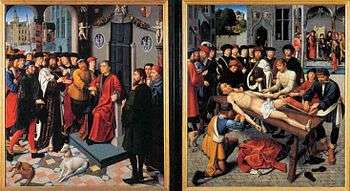The Judgement of Cambyses
| The Judgement of Cambyses | |
|---|---|
 | |
| Artist | Gerard David |
| Year | 1498 |
| Type | Oil on wood |
| Dimensions | 202 cm × 349.5 cm (80 in × 137.6 in) |
| Location | Groeninge Museum, Bruges, Belgium |
The Judgement of Cambyses is an oil on wood diptych by Dutch artist Gerard David, depicting the arrest and flaying of the corrupt Persian judge Sisamnes on the order of Cambyses, based on Herodotus's Histories. The diptych was commissioned in 1487/1488 by the municipal authorities of Bruges which requested a series of panels for the deputy burgomaster's room in the town hall.[1]
The diptych was painted on oak panels and was first mentioned in the Bruges' archives as The Last Judgement.[1] It was used by the town burghers to encourage honesty among the magistrates and as a symbolic public apology for the imprisonment of Maximilian I in Bruges in 1488.[2] The top right corner of the flaying scene features Sisamnes' son dispensing justice from his father's chair, now draped with the flayed skin.
There are also other paintings with the same subject, such as that by Dirck Vellert from 1542.
Usage in protests
David's The Judgement of Cambyses was used in August 2012 by the supporters of Yulia Timoshenko when they showed the reproduction of the work to the judge who was reviewing her case.[3] In November of the same year two activists showed the reproduction of The Judgement of Cambyses to the judge Andrey Fedin, who convicted Maxim Luzyanin, involved in the Bolotnaya Square case.[4]
References
| Wikimedia Commons has media related to The Judgment of Cambyses by Gerard David. |
- 1 2 "The Judgment of Cambyses". Web Gallery of Art. Retrieved 29 Dec 2013.
- ↑ Lee, Phil (2002). The Rough Guide to Bruges & Ghent. Rough Guides. p. 40. ISBN 1858288886.
- ↑ Суд над Тимошенко задекорировали картиной "Сдирание кожи с продажного судьи" (in Russian). Lenta.ru. Retrieved 29 Dec 2013.
- ↑ Давидиса и активистку Архипову задержали за попытку вручить судье Лузянина картину "о продажности" (in Russian). Gazeta.ru. Retrieved 29 Dec 2013.
External links
- Gerard David : purity of vision in an age of transition, fully digitized text from The Metropolitan Museum of Art libraries